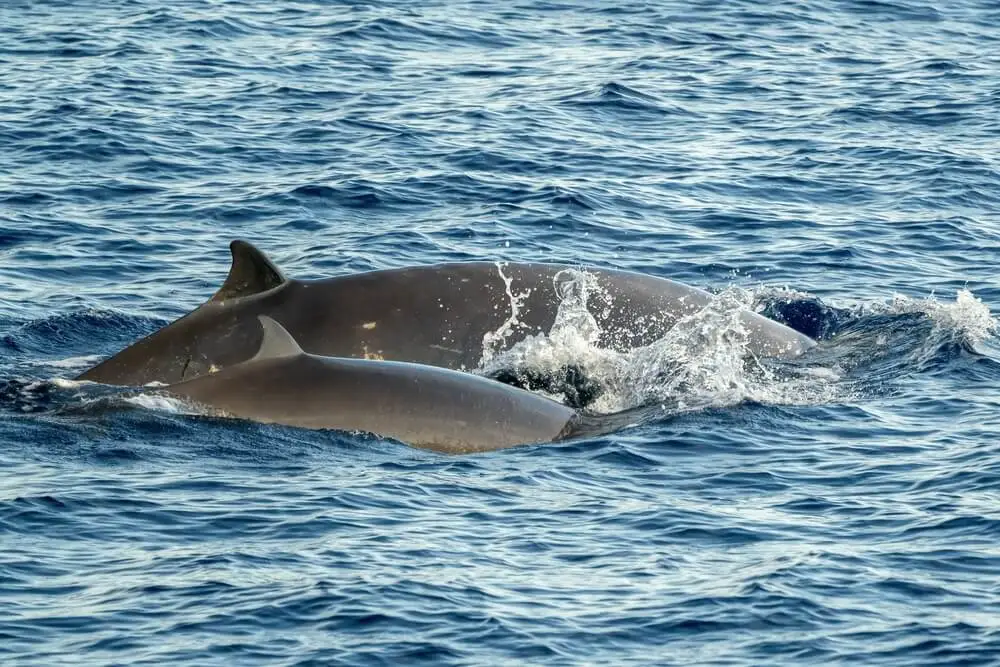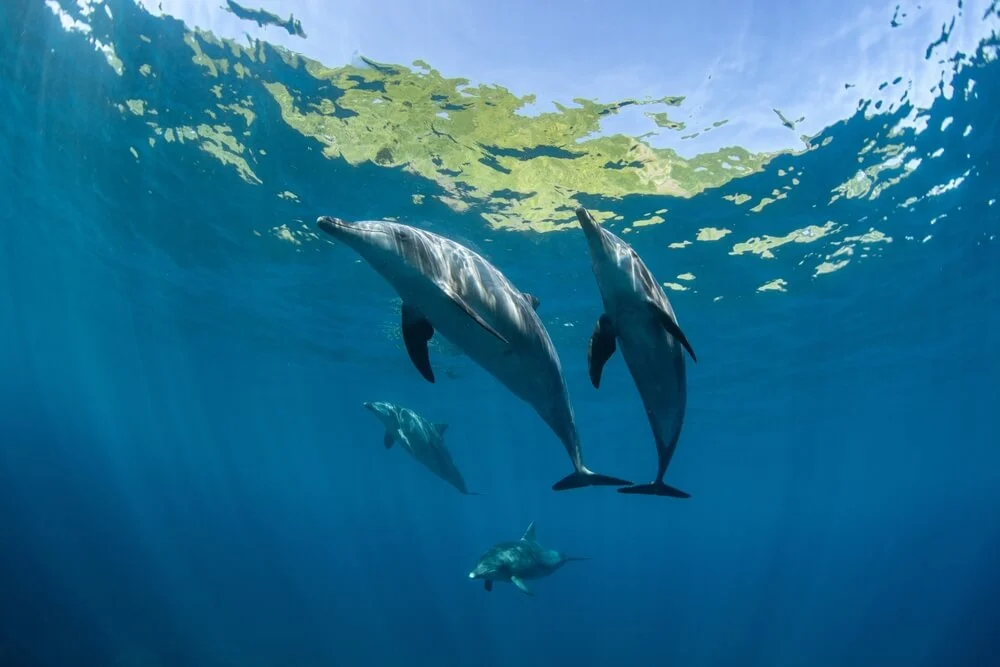With more than 90 species of whale in the world, it’s almost impossible to give a one-size-fits-all description for them.
For instance, as with their shapes and sizes, their speeds vary a great deal between species.
Whales can swim anywhere between 3-25 mph depending on the species. Most species are capable of swimming as fast or even faster than the average human when cruising. Even larger whales can reach much higher speeds than a human. Dolphins are taxonomically “toothed whales,” and they can swim even faster than true whales on average.
True Whales Can Swim Between 3 And 25 MPH

There are over 90 species of whale throughout the world. Therefore, there’s an incredible range of sizes, speeds, and behaviors among them.
Some of the fastest whales are also the largest, although that’s not always the case.
Large Whales Can Be Very Fast
The stereotypical image of a whale is one of an enormous animal.
After all, the blue whale is the largest animal in the world. It can grow to up to 98 feet (29.9 meters) long and weigh up to 400,000 pounds (181,436.9 kg).
However, the blue whale’s size is not a rarity. Although it does dwarf every other whale species, there are several that can still grow to incredible sizes.
For example, the sperm whale, humpback, right whale, and finback all grow to over 35 feet (10.7 meters).
But does their enormous size affect their speed? Speed depends on species, but one of the fastest species of whale on record is the fin whale.
This whale is second in size only to the blue whale and grows up to 88 feet (27 meters). Additionally, it can weigh up to 176, 369 pounds (80,000 kg).
Fin whales can move all of that bulk up to about 25 mph (40 km/h). That’s much faster than the fastest human speed of 5.3 mph (8.6 km/h).
On the other hand, another large whale, the North Atlantic right whale, swims at about the same speed as a human.
In fact, they are among the slowest swimming whales and on average, swim at about 6 mph (9.7 pm/h). However, they can reach speeds of 10 mph (16.1 km/h).
Speed Comparisons Of Different Whales
Because there are so many different species, it’s difficult to pinpoint the exact average speed of whales. Furthermore, some whales don’t have a well-documented speed at all.
But there are speeds recorded for certain whale species, and the numbers are diverse. Below is a sampling of various whale species, their sizes, and their swim speeds.
| Whale Species | Average Speed | Length | Weight |
|---|---|---|---|
| Fin Whale | 25 mph (40 km/h) | 88 ft (27 m) | 176, 369 lbs. (80,000 kg) |
| Blue Whale | 5-20 mph (8-32.1 km/h) | 98 ft (29.9 m) | 400,000 lbs. (181,436.9 kg) |
| Sperm Whale | 3-13 mph (6-21.5 km/h) | 66 ft (20 m) | 12,000 lbs. (55,000 kg) |
| Bowhead Whale | 4-13 mph (6-21 km/h) | 60 ft (18.3 m) | 200,000 lbs. (90,718.5 kg) |
| North Atlantic Right Whale | 6-10 mph (9.7-16.1 km/h) | 55 ft. (16.8 m) | 140,000 lbs. (63,502 kg) |
| Dwarf Sperm Whale | 3.5 mph (5.6 km/h) | 8.9 ft. (2.7 m) | 550 lbs. (250 kg) |
The lower speed ranges are typically the cruising speeds for these whales. This is how fast they swim during the normal course of their day. The upper speeds represent how fast they can go in short bursts.
Dolphins Are A Type Of Whale

The above information applies to “true” whales only. However, whales belong to the order Cetacea, along with dolphins and porpoises.
From orders, the taxonomic hierarchy continues down into suborders, families, genera, etc. In some cases, this is where the types of animals become more distinct.
For instance, the Reptilia class of animals breaks down into separate orders for crocodiles, amphibians, lizards, and so on. Those orders then breaks down even further from there.
With whales, however, there are only two suborders of Cetacea, and both of them are types of whales.
In other words, dolphins and porpoises are scientifically whales. They fall under the Odontoceti, or “toothed whales” suborder.
Are Dolphins Faster Than True Whales?
Within the Odontoceti suborder, there are 49 species of dolphin and porpoises. Like true whales, they come in a variety of shapes and sizes and swim at different speeds.
For example, one of the fastest porpoises is Dall’s porpoise, which can swim up to 35 mph (56 km/h).
Then there’s the orca, which many people know as a “killer whale.” It is, in fact, the largest species of dolphin.
Orcas cruise at about 8 mph (13 km/h), which is itself faster than the cruising speed of several other whales. If it pushes, an orca can swim up to 28 mph (45 km/h), if only for a few seconds at a time.
One of the slower dolphin species is the tucuxi dolphin, which cruises at about 13-14 mph (21-23 km/h). So even on the lower end, dolphins swim faster than true whales on the whole.
In Conclusion
Whales have a wide range of swim speeds. Depending on the species, a whale can cruise as slowly as three mph or as quickly as ten. Then, if they push themselves to the limit, some whales can get up to 25 mph, even the enormous ones.
What’s more, this only applies to true whales. Dolphins are actually a type of toothed whale. Even the famous “killer whale” orca is not a whale at all, but a large dolphin. They can swim even faster than the typical true whale.
In short, if including dolphins and porpoises, the upper limit of whale swim speed is closer to 35 mph. In general, though, the normal cruising speed of whales, including dolphins, is between three and 8 mph.
